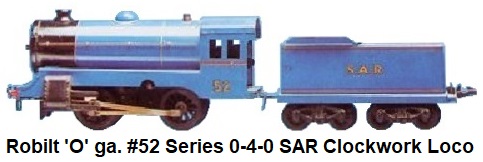 Following World War II Robilt produced 'O' gauge tinplate trains, rolling stock, and various line side accessories in Australia.
Robilt Products was established in Melbourne in 1946 by Ronald Titchener (1915-2000) who gained engineering experience in various
precision workshops before joining the Royal Australian Air Force in 1935. After serving in the RAAF in World War II
Tichener returned home to Melbourne and recognized that there was a shortage of tinplate toys in Australia due to the war-time embargo.
Up until the war, model trains had been imported to Australia from overseas manufacturers in Germany, England and the United States.
None of these trains however were representative of the regional railways that had operated in Australia.
Titchener subsequently went into business with accountant Bill Watts,
and they founded 'Robilt Products'. They set up a factory in a terrace of shops in the Melbourne suburb of Armadale, at 2A
& 2C Willis Street, and with a limited amount of equipment began making toys and prototype models of Australian trains.
Ron Titchener built the tooling and did the design work for these products.
Following World War II Robilt produced 'O' gauge tinplate trains, rolling stock, and various line side accessories in Australia.
Robilt Products was established in Melbourne in 1946 by Ronald Titchener (1915-2000) who gained engineering experience in various
precision workshops before joining the Royal Australian Air Force in 1935. After serving in the RAAF in World War II
Tichener returned home to Melbourne and recognized that there was a shortage of tinplate toys in Australia due to the war-time embargo.
Up until the war, model trains had been imported to Australia from overseas manufacturers in Germany, England and the United States.
None of these trains however were representative of the regional railways that had operated in Australia.
Titchener subsequently went into business with accountant Bill Watts,
and they founded 'Robilt Products'. They set up a factory in a terrace of shops in the Melbourne suburb of Armadale, at 2A
& 2C Willis Street, and with a limited amount of equipment began making toys and prototype models of Australian trains.
Ron Titchener built the tooling and did the design work for these products.

Several items were available for Christmas 1946 with distribution by Joy Toys,
a manufacturer and distributor dating back to 1930.
The first products were a clockwork locomotive and a small range of private owner goods wagons which carried
familiar local brand names like Peters Ice Cream or Atlantic Products and a number of tank wagons
in long and short versions featuring the various local oil companies COR, Plume, Golden Fleece, Shell,
Atlantic and Caltex branding. Robilt's other early products included an open goods wagon, a timber wagon
and a combined bogie breakdown van and crane. A four-wheel Victorian Railways' Z-type brake van came later along with
bogie timber wagons and box vans. Robilt also produced a clockwork crawler tractor model in 1947, and manufactured
'O' gauge accessories including a #63 level crossing, picket fencing, a #68 water tower, #66 signals and an assortment of stations.
The stations were named 'Richmond', 'Brighton' and 'Windsor'. Robilt eventually made its own 'O' gauge tinplate tubular track,
crossings and turnouts. Marketing and distribution changed from Joy Toys to Messrs Geo Wills and Co Pty Ltd.
Robilt became Australia's largest toy manufacturer as the product range continued to expand until the
early 1960's when the company turned its attention to producing small parts for the manufacturing industry.
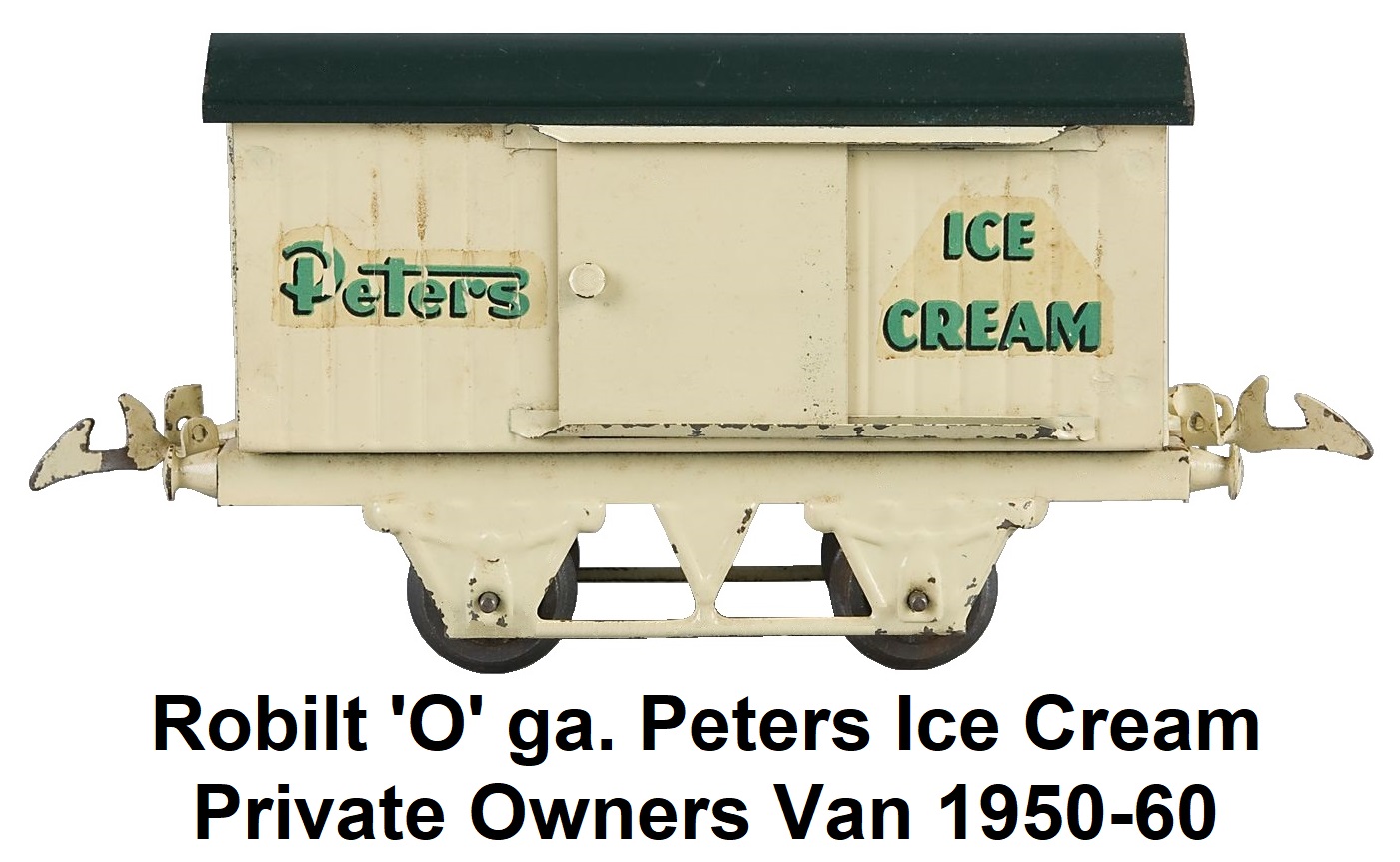
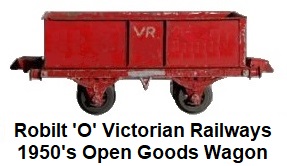
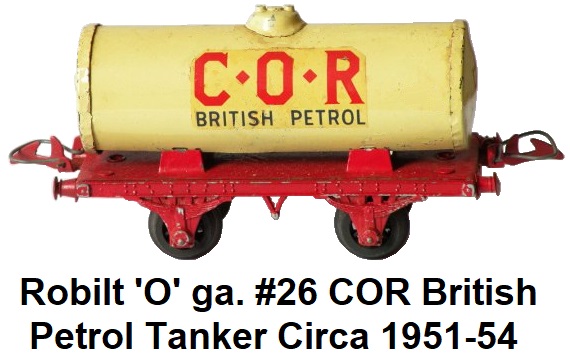

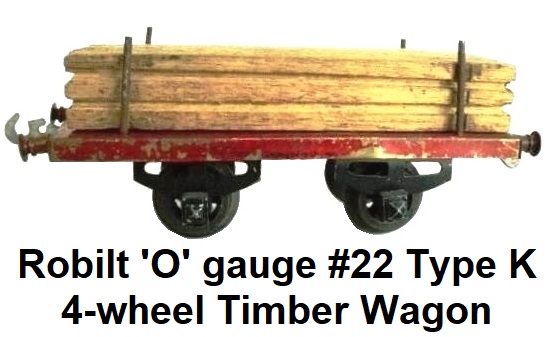
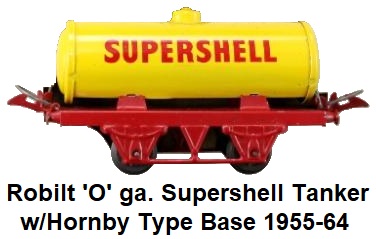
 Early Robilt locomotives were 0-4-0 and 2-4-0 steam outline configurations.
The first were 2-4-0 models fitted with a non-reversing clockwork mechanism thought to be made by the firm and is different from
the later models in that the cab had a single cut out window and a pair of ¼ inch (20 mm) diameter diecast
leading bogie wheels at the front. The early models also had a raised firebox section and were made of
spot welded sheet brass, which was then more readily available than the tin eventually utilized for the re-designed version.
Initial Robilt products used light gauge sheet brass, later switching to more traditional tinplate once the shortages of those
materials subsided.
Early Robilt locomotives were 0-4-0 and 2-4-0 steam outline configurations.
The first were 2-4-0 models fitted with a non-reversing clockwork mechanism thought to be made by the firm and is different from
the later models in that the cab had a single cut out window and a pair of ¼ inch (20 mm) diameter diecast
leading bogie wheels at the front. The early models also had a raised firebox section and were made of
spot welded sheet brass, which was then more readily available than the tin eventually utilized for the re-designed version.
Initial Robilt products used light gauge sheet brass, later switching to more traditional tinplate once the shortages of those
materials subsided.
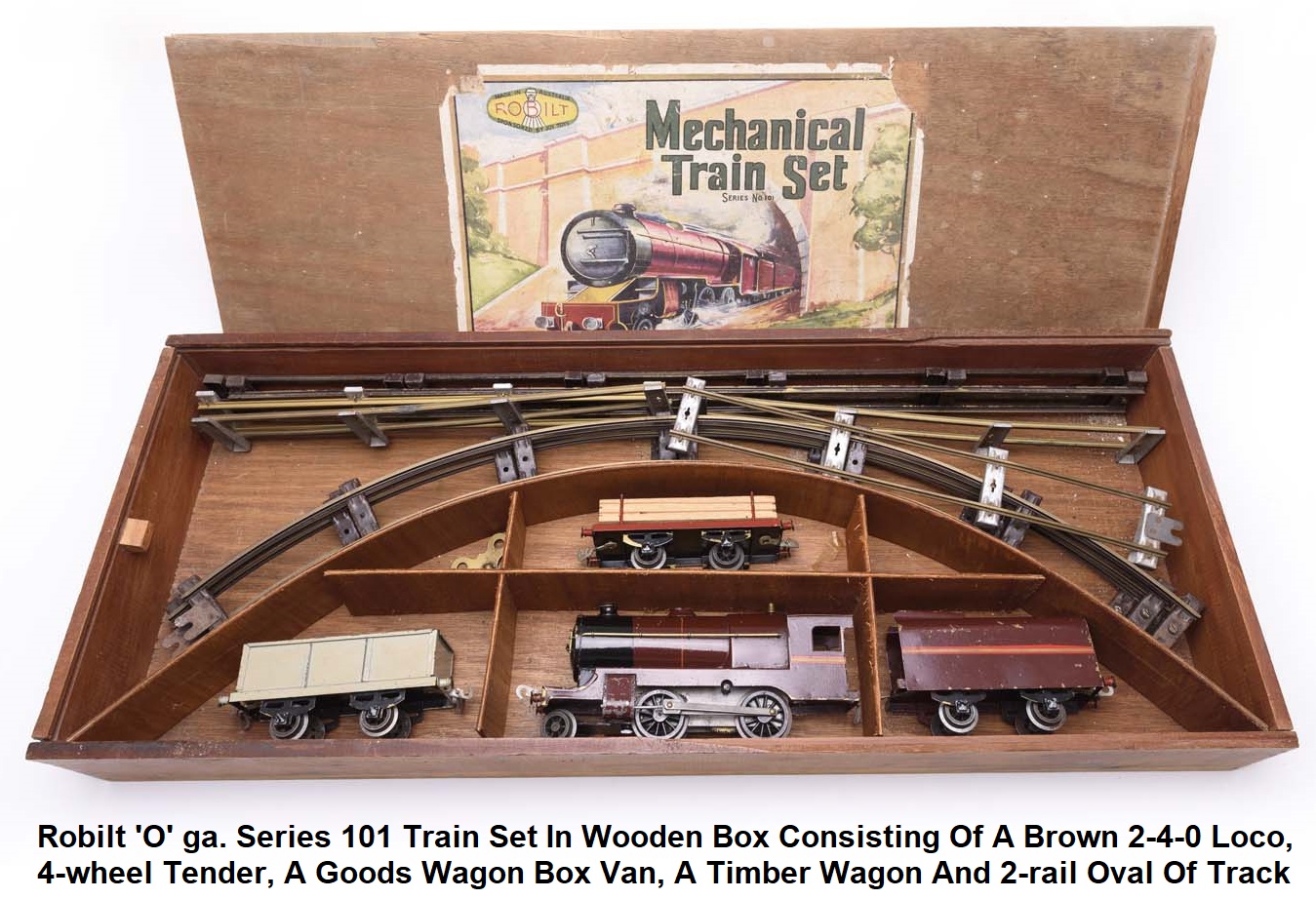
The redesigned loco was made into an 0-4-0 #11 with a shortened boiler around 1950. This locomotive carried
the running number '52' and became known as the 52 series. The accompanying 4-wheel tender was also modified to have flared sides.
The 52 series was one of Robilt's most popular products, becoming available in a number of different colors
with minor variations reflecting Victorian and New South Wales railway prototypes. The version with the S.A.R.
decal denoting the South Australian Railways was introduced in 1952. This loco remained in the line relatively unchanged
through 1964 with the exception of a modified 8-wheel bogie tender.

 In 1948 Titchener expanded his product line to include a streamlined passenger train, using the Victorian Railways Spirit of
Progress as his model reference. This was the first model produced by Robilt that was more scale-like and less toy-like. It
featured an 'O' gauge 4-6-2 locomotive and quaint first class bogie passenger coaches with
cut-out windows. The Australian Spirit of Progress prototype was the Victorian Railway’s most well-known express train running from
Melbourne to the New South Wales border at Albury, and later through to Sydney at speeds of up to 80mph. When introduced in 1937,
the train featured many innovations new or recently introduced to Australian railway practice, such as streamlining, full
air-conditioning, and all-steel carriage construction. Its overall exterior and interior design reflected the latest
Art Deco style, and interior fittings used materials such as stainless steel and native Australian blackwood veneers.
In 1948 Titchener expanded his product line to include a streamlined passenger train, using the Victorian Railways Spirit of
Progress as his model reference. This was the first model produced by Robilt that was more scale-like and less toy-like. It
featured an 'O' gauge 4-6-2 locomotive and quaint first class bogie passenger coaches with
cut-out windows. The Australian Spirit of Progress prototype was the Victorian Railway’s most well-known express train running from
Melbourne to the New South Wales border at Albury, and later through to Sydney at speeds of up to 80mph. When introduced in 1937,
the train featured many innovations new or recently introduced to Australian railway practice, such as streamlining, full
air-conditioning, and all-steel carriage construction. Its overall exterior and interior design reflected the latest
Art Deco style, and interior fittings used materials such as stainless steel and native Australian blackwood veneers.
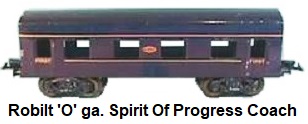 The luxurious new train also featured
a dining car with a modern galley kitchen modelled after the most up-to-date hospital kitchens of the period and, at the rear,
a round-ended parlour/observation car offering panoramic views. The top-of-the-line model that Robilt made was a fairly
good representation of the VR S class steam locomotive used to pull the Spirit of Progress train. The first Robilt Products
Spirit of Progress locomotives were clockwork spring driven with a new 6-wheel mechanism, but by the 1950's were electric
motor powered. The clockwork version was labeled the 'Edward Henty' while the electric version was named 'Matthew Flinders'.
These men were two prominent figures in early Victorian history and were also the names of two of the four Spirit of Progress steam
locomotives (S300 and S302) that serviced the Melbourne to Sydney route from 1937 to 1954.
The luxurious new train also featured
a dining car with a modern galley kitchen modelled after the most up-to-date hospital kitchens of the period and, at the rear,
a round-ended parlour/observation car offering panoramic views. The top-of-the-line model that Robilt made was a fairly
good representation of the VR S class steam locomotive used to pull the Spirit of Progress train. The first Robilt Products
Spirit of Progress locomotives were clockwork spring driven with a new 6-wheel mechanism, but by the 1950's were electric
motor powered. The clockwork version was labeled the 'Edward Henty' while the electric version was named 'Matthew Flinders'.
These men were two prominent figures in early Victorian history and were also the names of two of the four Spirit of Progress steam
locomotives (S300 and S302) that serviced the Melbourne to Sydney route from 1937 to 1954.

Robilt used three styles of coupling mechanisms on its trains during production,
the earliest being traditional drop link couplers, followed by a 'hooded' coupler of their own design and finally
the Hornby style auto couplers.
 In 1950 Ron Titchener sold Robilt to another Australian company, Playtime Toys, a manufacturer of
clocks and children's toy domestic utensils including a metal tea-set decorated with 'Alice in Wonderland' characters.
The firm was owned by Jack Ryding who was a watchmaker by trade and who had been supplying gears to Robilt.
Production moved to the Rytime company's factory at 218 Bay Road, Sandringham, in Melbourne. In 1952 the firm
traded under the name Rytime-Robilt and by 1954 Robilt Products. In 1953 electric trains were added to the catalogue
with 20-volt reversible mechanisms, later reduced to 16 volts supplied by Davis Electra Co. of Maroubra, in Sydney.
Davis Electra Co. also supplied the transformers that were packaged in the Robilt Electric Train Sets.
In 1950 Ron Titchener sold Robilt to another Australian company, Playtime Toys, a manufacturer of
clocks and children's toy domestic utensils including a metal tea-set decorated with 'Alice in Wonderland' characters.
The firm was owned by Jack Ryding who was a watchmaker by trade and who had been supplying gears to Robilt.
Production moved to the Rytime company's factory at 218 Bay Road, Sandringham, in Melbourne. In 1952 the firm
traded under the name Rytime-Robilt and by 1954 Robilt Products. In 1953 electric trains were added to the catalogue
with 20-volt reversible mechanisms, later reduced to 16 volts supplied by Davis Electra Co. of Maroubra, in Sydney.
Davis Electra Co. also supplied the transformers that were packaged in the Robilt Electric Train Sets.
An 0-6-0 tender locomotive #16 was introduced in 1953 as part of the 52 series. A reversing facility was added
to the clockwork locomotives in 1954. By this time the firm was making their own
tinplate track with a rail rolling machine. In 2005 this machine was owned by Alan Middleton who continued to
produce authentic 'O' gauge track for local Australian model railway enthusiasts. The mid-1950's represented the peak
period of production at Robilt with 10 workers being employed, but from there on a slowdown commenced. By the
1960's toy production had wound down and the company was making small gemstone finishing machines for
hobbyists. The rise in popularity of smaller gauges and the advent of television saw Robilt
and most other Australian manufacturers unable to compete with the overseas products, and they were being forced to
diversify into other areas during the 1960's. Robilt produced more than just toy trains, producing machinery for the
jewellery trade and, later, the automotive industry.


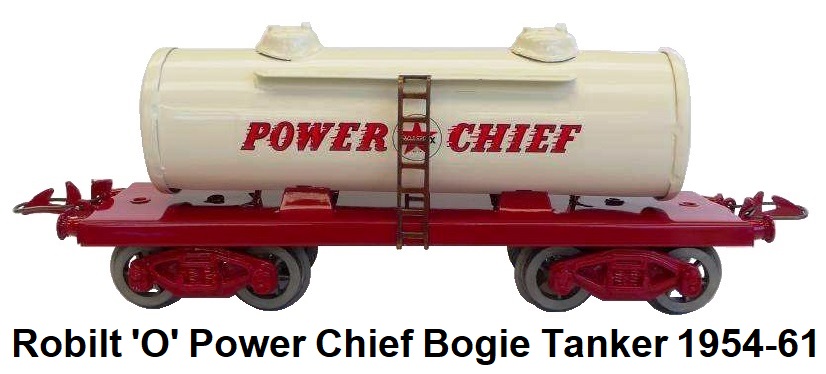
In addition to the toy and model trains that Ron Titchener designed and built, he also
fabricated and supplied a multitude of accurate scale models for various commissions and museums during his
lifetime. These included detailed models of Victorian Railways steam trains such as the Spirit of Progress and other VR
locos for the Victorian Railways centenary celebrations held in 1954. He also modeled working oil well pumps, automobiles
and other steam powered and horse drawn vehicles. Titchener also spent time working in a factory making yacht fittings.
He passed away on May 24, 2000 at the age of 85.

Some of the photos and information included on this page were obtained with permission of Stuart Mangelson of the
Hornby Railway Collectors Association of Australia from his writings on Robilt Trains.
